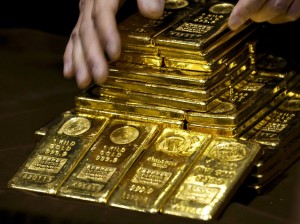 Gold traded little changed after two days of declines, following the release of the Federal Reserve minutes, which boosted expectations the central bank will continue scaling back its stimulus program during 2014, diminishing demand for gold. A weaker dollar relieved some pressure on the yellow metal. However, assets in the SPDR Gold Trust, the biggest bullion-backed ETF, were further reduced to a 5-year low, adding to bearish sentiment.
Gold traded little changed after two days of declines, following the release of the Federal Reserve minutes, which boosted expectations the central bank will continue scaling back its stimulus program during 2014, diminishing demand for gold. A weaker dollar relieved some pressure on the yellow metal. However, assets in the SPDR Gold Trust, the biggest bullion-backed ETF, were further reduced to a 5-year low, adding to bearish sentiment.
On the Comex division of the New York Mercantile Exchange, gold futures for settlement in February traded little changed at $1 225.80 per troy ounce by 08:16 GMT, adding 0.02% for the day. Prices swung between day’s high and low of $1 227.40 and 1223.50 per troy ounce, respectively. On January 6th, prices touched $1 247.70 an ounce, the strongest level since December 16th. Gold futures settled last 5-day period 1.95% higher, the largest advance in ten weeks. However, the precious metal settled last year 28% lower, the steepest annual decline since 1981, as investors lost faith in it as a store of value amid a rally in U.S. equities to a record and muted inflation.
Fed stimulus outlook
The Federal Reserve Bank said on December 18th that it will reduce its monthly bond purchases in January to $75 billion from $85 billion. Yesterday, Fed minutes revealed decreasing economic benefits from the bond-buying program, which increased bets that Fed policy makers might extend reductions in their monetary stimulus program in the near future.
“The Federal Reserve minutes undermined gold as the release may have increased expectations that the Fed may announce further ‘tapering’ at the subsequent meetings,” said James Steel, an analyst at HSBC Securities (USA) Inc., cited by Bloomberg.
Investors awaited the release of a report by the US Labor Department on non-farm payrolls for December. According to the median analysts forecast, employers probably added 195 000 workers last month, down from 203 000 in November. Yesterday, a report by the ADP research institute revealed the US private sector added 238 000 workers in December, the most since January 2012, defying analysts’ projections of a decrease to 200 000 from 215 000 workers in November. The ADP report is calculated according to the same methods the Bureau of Labor Statistics uses and is published every month, two days before the official BLS employment rate statistics.
Gold was further pressured after a recent series of upbeat US economic data supported Fed’s tapering decision and sent equities rallying.
On Monday, the US Census Bureau released a report that showed the nation’s factory orders increased by 1.8% in November, after declining 0.9% in October, while analysts predicted the factory orders will increase by 1.7%.
On Tuesday, the US Commerce Department reported that the US trade deficit narrowed to $34.25 billion in November, defying analysts’ projections that the trade deficit will widen to $40.00 billion. In October the US trade deficit was downwardly revised from $40.64 to $39.33 billion.
Data showed that the US imports declined 1.4% to $229.1 billion, while exports rose 0.9% to a record high $194.9 billion.
According to the median estimate of economists surveyed by Bloomberg on December 19th, the Federal Reserve may reduce the purchases in $10 billion increments over the next seven meetings, before ending the program in December 2014.
A weaker dollar supported the yellow metal. The U.S. dollar index, which measures the greenback’s performance against a basket of six major peers, declined 0.09% to trade at 81.14 by 08:14 GMT. Prices shifted in a daily range between day’s high and low, 81.25 and 81.12. The US dollar index settled last week 0.7% higher. Weakening of the dollar makes commodities priced in it cheaper for foreign currency holders and boosts their appeal as an alternative investment.
Assets in the SPDR Gold Trust, the biggest bullion-backed ETP, were further reduced to 793.12 tons on Wednesday, the lowest since January 2009, data on the website showed. The fund has lost 41% of its holdings in 2013. A total of 553 tons has been withdrawn in 2013. Billionaire hedge-fund manager John Paulson who holds the biggest stake in the SPDR Gold Trust told clients on November 20 that he wouldn’t invest more money in his gold fund because it isn’t clear when inflation will accelerate.





